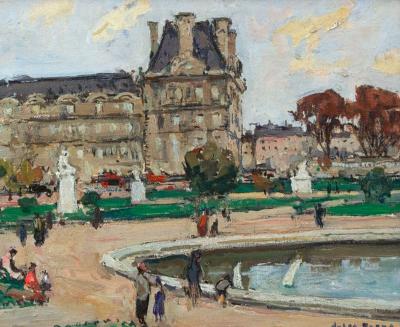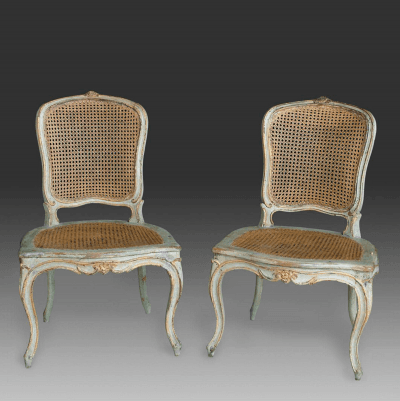Impressions of Interiors
Gilded Age Paintings by Walter Gay
This archive article was originally published in Antiques & Fine Art magazine.
A major exhibition of work by American artist Walter Gay (1856–1937) on display at the Henry Morrison Flagler Museum in Palm Beach, Florida, examines the life and work of an American artist who specialized in painting the sumptuous domestic interiors of wealthy collectors and society figures in late-nineteenth and early-twentieth-century America and Europe. Impressions of Interiors, organized by the Frick Art & Historical Center, features sixty-nine paintings and a selection of historical materials on loan from forty public and private collections including: the Art Institute of Chicago; Museum of Fine Arts, Boston; Metropolitan Museum of Art; Musée d’Orsay; and the Smithsonian American Art Museum. Many of these works have not been publicly exhibited since Gay’s lifetime.
John Singer Sargent, Gay’s contemporary, is well known for painting the lavish clothing and jewels of American society in his fashionable portraits. Walter Gay, in contrast, painted society’s luxurious domestic spaces, with rich silk wall coverings, ornate paneling, eighteenth-century French furniture, tapestries, and sculptures. Impressions of Interiors is a comprehensive exploration of Walter Gay’s depictions of elaborately decorated European and American domestic interiors, painted from the mid-1890s to the early 1930s. These paintings serve as documents of the collecting, decorating habits, and taste of the period, and mirror the collectors’ perspectives on the past.
Walter Gay’s paintings are not about careful delineation or accurate documentation of a particular room and its contents. Rather, Gay’s works—always made on site, never from photographs—are interpretations of these spaces, made distinctive by Gay’s evocative use of color and light, and his painterly touch, which creates a sense of life even though there is typically no human presence. The objects and the furnishings themselves become the characters that inhabit Walter Gay’s interiors.
Born in Hingham, Massachusetts, Walter Gay showed artistic promise in his childhood. He began to seriously pursue a career in painting in 1873, when he joined a Boston studio group and attended drawing classes at the Lowell Institute. Like many art students of his day, Gay traveled to France to study, but unlike others, Gay did not limit his social life to an insulated expatriate community; he learned French and became friends with well-known fellow artists such as Edgar Degas and August Rodin, as well as the international social set.
Walter Gay began his European artistic career in 1876 studying with French academic painter Léon Bonnat. Early on, Gay visited Barbizon, and created genre paintings populated with pious, earthy peasants. He was more interested, however, in capturing the texture and tone of the environment, conveying a human presence in domestic spaces without actually portraying the inhabitants of those spaces. Around 1895, he essentially eliminated the figure from his paintings and began to paint portraits of rooms.
In 1889, Walter Gay married wealthy American heiress Matilda Travers (1855–1943). The two shared an interest in collecting and entertaining. Matilda’s social connections helped to introduce Walter’s work to a wider circle of Gilded Age personalities. Both avid collectors of antiques and fine decorative arts, their flair for presenting their collection within their home is beautifully documented in his many paintings of their own residences—from Paris apartments to sprawling chateaux—which capture the stylish and comfortable way the Gays furnished their personal spaces. Figure 1 depicts a portion of the artist’s collection, including a pair of drawings by Watteau framed together at right, in his study in their elegant Left Bank apartment. In 1897, the couple rented the nineteenth-century Château de Fortoiseau, about thirty miles southeast of Paris, and furnished it with their collection of Chinese and Japanese porcelains and eighteenth- and nineteenth-century French furniture. The château’s grand spaces proved inspiring, and Gay painted many views of the interior. Matilda Gay Reclining on a Lit de Repos (Fig. 2) provides an intimate glimpse into the couple’s life at Fortoiseau. The painting depicts Matilda, reclined on a green striped sofa. In the mirror, Gay has shown himself at his easel. The painterly handling of surfaces and the complex treatment of light, and reflections in the mirrored wall panels, all attest to Gay’s fascination with the use of transient effects to animate interior spaces.
At a time when interior decorating was becoming professionalized by figures like Edith Wharton (Fig. 3 is a view of her bedroom by Gay) and Elsie de Wolfe, Walter and Matilda Gay were part of an international Rococo revival. It was a movement that combined concepts of good taste with comfort and personal style, during which the display of collections and the furnishing of rooms with a cohesive style became important. The Gays and their social circle particularly loved eighteenth-century French furnishings and decorative arts, but often used these objects in a fresh, more twentieth-century way, rather than slavishly imitating the eighteenth century that inspired them.
For the last thirty-five years of his career, Walter Gay created what have been called “poèmes d’intérieurs”—his characteristic works—lush, painterly, and carefully observed interpretations of domestic spaces. An exhibition of paintings made at Fortoiseau marked Gay’s first public showing of interiors. By 1905, the paintings of interiors had transformed his career and made his reputation. That year, seventeen paintings were sold from a solo exhibition in Paris and he was soon being commissioned to portray rooms, both public and private. The next year, the Gays purchased their own chateau, Bréau, which was to prove a subject he returned to again and again, in spite of the increasing number of commissions he began to receive.
Gay’s commissions to produce paintings of rooms in private residences turned public museums—like his work at the Jacquemart-André in Paris and the Frick residence in New York—provide a unique opportunity to compare his work to spaces that still exist in essentially their original form. Nélie Jacquemart-André, a portraitist who turned society hostess after marrying one of her clients, the banker Edouard André, left their mansion in Paris and its contents to the Institut de France upon her death in 1912. Before opening the house as a museum for the public, the curator, Monsieur Berteaux, invited Gay to paint the Grand Salon. Although upheld by some as the epitome of eighteenth-century decor, the Grand Salon did not seem to entirely satisfy Gay’s taste. Salon in the Musée Jacquemart-André (Fig. 4) departs significantly from its source. Gay altered and simplified the boiserie, introduced a marble fireplace similar to one in a nearby room, and included a portrait of an unknown woman and a bust on the mantel that may not have been part of the collection. In the case of the Jacquemart-André paintings, it is clear that Gay did not perfectly delineate the exact particulars of rooms, but instead, was inspired by them, using them as points of departure for his interpretations of the spaces.
Helen Clay Frick, like many of her contemporaries, sought out Walter Gay to record the “spirit” of the spaces in what was then her family home, The Frick Collection in New York. The three resulting paintings, including The Boucher Room (Fig. 5) and The Fragonard Room (Fig. 6), are part of the collection at the Frick Art & Historical Center, and provided the inspiration and foundation for this reexamination of Walter Gay’s work.
Today, Gay’s interiors are held by private and public collections in the United States and Europe. Though Gay’s work was certainly known in America during his lifetime, he enjoyed more renown in Europe throughout his career. “The French are so much more appreciative of my husband’s work than his compatriots—the Americans have not yet ‘caught on,’” noted Matilda Gay of the artist’s one-man exhibition at the Galerie Georges Petit in 1905. Walter Gay died at his home, Château du Bréau, on July 13, 1937. His New York Times obituary declared him the “dean of American artists in Paris.” A memorial exhibition of his work in 1938 at the Metropolitan Museum of Art consisted solely of interior views held in American collections. Many of the works were lent by Gay’s prominent friends and patrons, including Helen Clay Frick. “Traversing this exhibition I have been moved by the beauty with which the pictures in it reproduce interiors I have known,” wrote Albert E. Gallatin in his review of the show. “At the same time I have been conscious of the beautiful nature out of which they proceeded, the man who was as lovable as the artist.”
This article was originally published in the 13th Anniversary issue of Antiques & Fine Art magazine, a fully digitized version of which is available on afamag.com AFA is affiliated with Incollect.





































